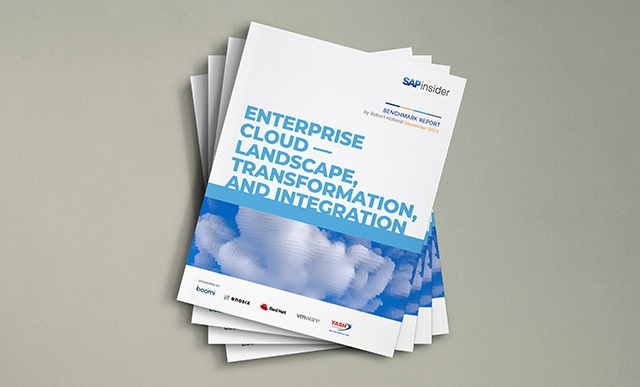MythBusters: Why Customer Obsession Is Key for Successful SAP Migrations to the Cloud
by Axel Streichardt, Head of Worldwide Business Development, SAP on AWS, Amazon Web Services

Axel Streichardt came to Amazon Web Services (AWS) as Head of Worldwide Business Development for SAP on AWS in May 2020. Prior to AWS, Axel had 20+ years of experience in developing customer solutions for Global 2000 customers to run SAP applications on premises or in the cloud. In his current role at AWS, Axel works backward from customers’ goals to drive new levels of efficiency by running their SAP applications on AWS.
In my more than 20 years of experience working with SAP customers around the world, I have realized that enterprises are constantly on a journey, often seeking reliability, agility, and security, all while trying to control and lower the cost of running their SAP landscapes. Customers in various industries are also seeking to achieve business value where technology is the enabler. Of course, many customers are looking at the cloud as a deployment option; in fact, many customers already have a cloud-first strategy, but are hesitating when it comes to their most mission-critical application, SAP. I’ve heard several reasons for this hesitation to migrate SAP workloads to the cloud: uncontrolled costs to migrate and run SAP systems, inflexible service-level agreements (SLAs), an increase in downtime, and security issues.
This article dispels the myths behind these misconceptions about moving to the cloud, and it illuminates for SAP customers the many benefits they can gain by bringing their SAP systems to a hyperscale environment such as Amazon Web Services (AWS).
A Long History of Helping SAP Customers
As a famous CEO once said: “There is no compression algorithm for experience.” This is especially true for SAP customers. AWS has a proven track record of helping SAP customers manage their complex data landscapes. In fact, SAP has been an AWS customer since 2008 and has been certified and supported since 2011. Today, more than 5,000 SAP customers trust AWS as the platform of choice. One such customer example is Moderna, a pharmaceutical company also developing vaccines. Moderna migrated its SAP environment to AWS to help rapidly uncover new insights to get potentially life-saving treatments into production faster. Additionally, a recent IDG survey shows that SAP customers using AWS experience business benefits such as enhanced innovation, faster time-to-market, and improved customer relationships — with 43% of SAP customers on AWS for more than two years reporting improved organizational efficiency.
In 2020, AWS was named a leader in cloud infrastructure and platform services for the 10th consecutive year, and it has been lauded for years as a leading SAP service provider for the SAP HANA platform and cloud infrastructure. Why is that? The secret is the most important AWS leadership principle: customer obsession. We work backward from the customer and consider their requirements and requests, and the real needs and strategies for their SAP journeys. To do that, of course, we first need to dive deep to truly understand what our customers are telling us about their challenges and pain points before suggesting solutions. AWS aspires to become a trusted advisor to customers by thoroughly assessing their current SAP landscapes and analyzing their cloud readiness. We provide tools and services to mobilize customers and migrate them to the cloud. But the journey does not end once they are reliably running mission-critical SAP workloads in the cloud. Customers seek to expand and integrate SAP systems to gain better insight into their data and to drive business value. I believe there is no better place than AWS to integrate SAP systems with technology, such as data analytics, artificial intelligence (AI), machine learning (ML), or Internet of Things (IoT), because AWS has mastered using these technologies for a successful customer experience. In the end, it is the customer’s choice and decision on how fast and where the SAP journey goes. We work with them to ensure it will be a successful journey and prepare for any unforeseeable circumstances along the way.
Providing Agility in Tough, Unpredictable Times
We live in very unpredictable times, and the last 12 months have shown that businesses have to react quickly to unforeseen events or external forces. SAP customers have to not only be flexible, but also innovate new services rapidly. For example, with business models and business processes changing frequently over the last year, organizations had to find new ways to connect with their customers, with extremely tight budgets. This leads to more innovation and automation. AWS, for instance, helps enable these changes by fully automating administrative tasks, such as SAP copy, clone, and refresh, to free up an organization’s resources — that is, time, people, and budget. In my conversations at the recent virtual AWS re:Invent event, customers told me that they could reduce the resources necessary to manage their SAP systems by 30%–40% using AWS tools and services. Other customers, such as The Kellogg Company, could save over $900K and run dozens of marketing simulations a day.
Another area for consideration is the flexibility needed to gain a competitive advantage and to handle increased demand seamlessly. For example, Netflix and Peloton both saw a dramatic increase in business as demand for their products skyrocketed over the past year, and they had to immediately spin up more resources without downtime. Running on AWS helped these companies to capitalize on the business opportunity presented to them, because more compute, storage, and network resources could be automatically increased.
Unpredictable times also have an impact on the path customers take during their SAP journeys. The majority are still running SAP ERP knowing that SAP extended the deadline to migrate to SAP S/4HANA to 2027 (with optional extended maintenance through 2030). I’ve talked with large customers that stepped on the brakes with their SAP S/4HANA migration plans to focus on modernizing their current environments, migrating to AWS with increased automation, data insight, and a more holistic view on business outcomes and predictive analytics. For example, the Volkswagen Group (VWCO) is one of the largest truck and bus manufacturers in South America to decide to deploy a new ERP system, choosing SAP S/4HANA — hosted by AWS. VWCO recognized a reduction in costs and increased agility, with the ability to perform production server upgrades in only 20 minutes.
Many customers have a cloud-first, or even cloud-only strategy, to reduce costs and complexity and gain agility; but migrating SAP systems is another caliber. It is mission critical and even minutes of downtime can translate to a loss of millions in revenue or a hit on trust in the brand. Earning trust is another of AWS’ leadership principles, which is why we work with customers on building this trust. I have seen that customers’ cloud adoption journeys very often start small, with low-risk, low-cost workloads migrated first. Many customers start with SAP archiving projects, or backup and recovery, and gradually move to high availability (HA)/disaster recovery (DR) workloads, followed by test/development environments to ultimately migrate their entire SAP production landscapes onto AWS, using AWS best practices to deploy, optimize, and modernize. I recently spoke with a large software/hardware company that shared its SAP migration journey and needed advice on improving its current SAP HANA backup and restore strategy. I suggested using AWS Backint Agent for SAP HANA, an SAP-certified backup and restore solution for SAP HANA workloads running on Amazon EC2 instances. It backs up the SAP HANA database to Amazon S3 and restores it using SAP management tools, such as SAP HANA cockpit, SAP HANA studio, or SQL commands. I shared that AWS Backint Agent supports full, incremental, differential, and log backup of SAP HANA database and catalogs to Amazon S3. As a result, the customer shared that the business could increase backup/restore performance by a factor of 10x.
It is all about choice and options, and we help customers throughout their SAP migration and cloud migration journey. As I said, we’re customer obsessed.
Addressing the Current Challenges for SAP Customers
SAP customers are currently dealing with several challenges — namely cost, availability or avoiding downtime, performance, security, and integration — that AWS can help address.
Cost
One common topic in my customer interactions is the cost of running SAP systems:
- Infrastructure costs: Customers are looking to optimize their data center compute, storage, and network resources, but often lack full cost control over their entire infrastructure. In the on-premises world, companies have to size and build infrastructures for SAP systems to accommodate peak times. These resources are idling and unused over 90% of the time, and are difficult to assign to other workloads. With AWS, they can scale up and down — and only pay for what they use, such as Hoya, who could reduce its capital expenditures for infrastructure by 80% to 90% over three years. Other infrastructure costs are associated with spinning up and down test systems or sandboxes. It takes days or weeks and is rather costly to set up systems for a “quick” test. Our customer Lockheed Martin gained agility to spin test systems up or down as needed in hours rather than days, therefore seeing reduced operational cost. We also saw at BP a 33% reduction in cost for SAP systems while increasing performance by 40%.
- Migration costs: Due to complexity and duration, migration costs often exceed operational expenses. SAP migration projects can take months to years to complete, and as customers start to consider their SAP migrations from SAP ERP to SAP HANA or SAP S/4HANA, they want to understand the advantages of first migrating their SAP systems to AWS. They want to know if a cloud infrastructure can help cut migration costs and/or the time required to execute the migration. AWS’ SAP ProServe team has successfully helped many customers with their migrations. In addition, the AWS partner network is a group of global system integrator (GSI) ISV partners that can help drive innovation-led business transformation, mitigate migration costs, and create efficiencies for customers. Our new independent software vendor (ISV) partner path can help expedite customers’ engagements with AWS, and the AWS competency program identifies, validates, and promotes partners with demonstrated AWS technical expertise and proven customer success. For example, our customer Dole accelerated the time to develop and deploy from 10 months to 10 weeks and went from eight resources to two, reducing its migration costs by 5% due to a reduction in its ABAP code.
Sometimes it is not the direct cost associated with software or hardware, but more the cost of avoidance. As described previously, just a few minutes of downtime can have a costly effect, which is why customers are demanding HA and DR solutions to protect their SAP landscapes from downtime. AWS offers 99.99% uptime for compute resources (EC2) and 99.999% of uptime for storage (EBS – io2). What is more relevant is the annual normalized uptime report, published by all hyperscalers. Looking at that data then, AWS is the most reliable cloud to run your SAP workloads. An example of this is Louisiana Pacific, who achieved a 20% application performance improvement, 24×7 availability, and improved disaster recovery using the CloudEndure Disaster Recovery suite and SAP HANA system replication capabilities.
Availability
While no service providers disclose the exact location of their data centers around the world, for obvious security reasons, location certainly matters to customers when it comes to ensuring availability. They want to know their data is stored in a secure, protected, and safe way and is highly available in case a disaster strikes. AWS has 24 active geographic regions — a region is a physical location in the world where we have multiple availability zones (AZs) — with 77 AZs (which consist of one or more discrete data centers, each with redundant power, networking, and connectivity, housed in separate facilities; applications and data are replicated in real time and consistent in the different AZs) and multiple AZs in every region. Customers such as Whirlpool or Philips 66 are leveraging AWS AZs for HA and DR solutions.
Performance
AWS is designed to ensure that customers receive the performance they require. As SAP HANA is a low-latency application, we provide performance-based instances and can seamlessly scale up these customers from very small (256GB) to very large — all the way to 24TB in scale-up, and up to 48TB in scale-out, running on AWS’ innovative Nitro system. It is providing 100% performance of high memory instances, including dedicated hardware accelerators that offer and manage direct connectivity to Amazon VPC and Amazon EBS. In addition, AWS has different ways of helping customers with any data latency/residency and compliance issues that are caused by customer location, especially with deployments at the edge or in countries with low latency network connections. To overcome these issues, we offer AWS Outposts, which is a managed service that is deployed on premises in your data center and looks just like an AWS appliance in the cloud. Customers use this appliance to capture any data with low latency requirements before sending it to the next AWS data center. When it comes to performance, our customer Liberty Mutual uses AWS services, along with SAP S/4HANA, for real-time financial closing. Another customer, Heineken, shared during the AWS re:Invent keynote that it estimates its 42TB system on AWS is half the cost of the 6TB system it used to be on premises.
Security
System security is another area of top concern for customers. Security is “job zero” at AWS. SAP on AWS provides security not only by preventing system break-ins, but also by supporting and applying some of the tightest security standards in the world to organizations and governmental agencies. Through our security principles and practices, we help keep our customers’ data centers safe and secure from cyberattacks and data breaches. With over 265 security features, dedicated network connectivity between AWS data center and availability zones, plus the highest standards on end-to-end encryption technology, AWS keeps customers’ data safe. AWS is also collaborating with SAP National Security Services (SAP NS2) to help public sector customers run the most mission-critical and sensitive SAP HANA workloads on AWS. The US Navy and SAP NS2 migrated their largest SAP ERP system — 72,000 users spread across six US Navy commands — to AWS. The milestone — which came 10 months ahead of schedule — will put the movement and documentation of some $70 billion worth of parts and goods into one accessible space, so the information can be shared, analyzed, and protected more uniformly.
Integration
SAP customers are constantly innovating and expanding their SAP landscapes and integrating with non-SAP systems. They are demanding integration solutions, not building blocks to incorporate all the data and systems into their SAP landscapes. The ability to build predictive analytics data lakes that combine SAP and non-SAP data requires a seamless connection and integration of those systems. Customers such as Zalando built a data lake solution with SAP and non-SAP systems using AWS Glue and AWS Lambda to consolidate all the information in Amazon S3, using Amazon Redshift for end-user analysis. The end result — the ability to track performance in near real time and the reduction of the cost of obtaining business insight by 30%. Pharmaceutical company Bristol Myers Squibb was challenged to increase speed for its drug testing and deployed SAP AWS data lakes with AWS Lambda, AWS Glue, Amazon Athena, Amazon Redshift, and Amazon SageMaker. This has helped the company to quickly deploy new data points without having to consider infrastructure, scalability, or availability, but instead concentrate on building business logic. Running SAP on AWS resulted in a 92% time reduction in running simulations. During the recent AWS re:Invent event, AWS announced the availability of AppFlow for SAP software in Q1 2021, which will stream data seamlessly from SAP systems and SAP HANA to Amazon S3, simplifying the process of building an analytics data lake.
Help Beyond the Transition to SAP S/4HANA
No crystal ball is required here. We all can see in the coming years that customers will be transitioning from SAP ERP to SAP Business Suite powered by SAP HANA or directly to SAP S/4HANA, but as I said, the SAP journey does not end there. As I described before, customers will continue to innovate by expanding their SAP solutions into new areas such as AI, ML, IoT, and building data lakes for better insight to make more accurate, fact-based decisions. Many of these customers are on the cloud migration path already, but even if your company decided to stay on premises with its SAP landscape, these services are also available to you to start your data integration and build an intelligent SAP enterprise, using SAP’s term. Again, we want to give customers a choice and always work backward to provide solutions to achieve their goals. I often hear in my customer conversations, “I did not know that,” or “I thought that AWS was more expensive,” etc., which is why I shared some customer conversations (and use cases) to clarify some of the misperceptions and provide more detailed information to help you make an informed decision about your SAP cloud migration journey to AWS.
To learn more, visit https://www.aws.amazon.com/sap.








